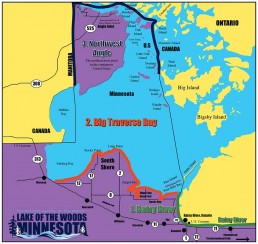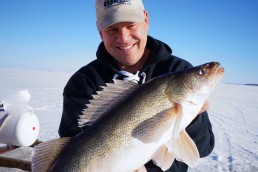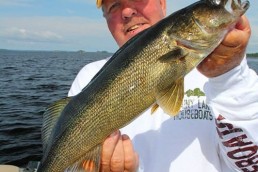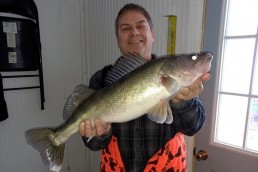Winter Walleye Movements on Lake of the Woods
SHARE THIS POST
They don’t call it the “Walleye Capital of the World” for nothing. Even on a walleye factory like Lake of the Woods, anglers still have to position themselves on fish. If you’ve been there before, you realize there is a lot of water. Understanding the typical walleye patterns and movements can help put more fish on the ice.
With such a diverse watershed, it helps to break it down and understand the three parts of the area.
The first is the Rainy River. As an international border with Canada that flows out of Rainy Lake 60 miles to the east, Rainy flows west to Baudette and turns north another 12 miles where it dumps into LOW. A few resorts ice-fish this river, closely monitoring the ice. Because it’s a flowing river and ice conditions vary greatly, we strongly suggest working through a resort or guide and not venture out on your own. The second portion is Big Traverse Bay, a main basin of the lake that extends 30 miles north/south by 25 miles east/west. This area is fished by resorts, has ice roads for those on their own and extensive groomed and staked snowmobile trails across the lake. The third portion of LOW is the Northwest Angle. This is the northernmost point of the continental U.S., and where the 14,552 islands of the lake really begin.
Big Traverse Bay
Ice fishing in this area is dependent on weather and the ice, and it typically begins the end of November or the beginning of December and continues through March. Often, resorts will work to mark an initial trail for ATV traffic only. As ice thickens, the resorts will begin to pull out permanent fish houses. On average, rental fish houses go out around December 10.
Early ice can be excellent for fishing as the walleyes are still close to shore and concentrated.
“We see some nice fish early and believe that walleyes from the Rainy River start moving back into the lake sometime between Christmas and New Year’s,” explains Lanny Vollmer, a guide at Border View Lodge, who has 17 years on the lake. “Around that time we will turn the lights on in the fish house each morning and the holes will be full of emerald shiners.”
He added between the oxygen levels dropping in the river and shiners moving into the lake, walleyes move in and push shiners up into the holes. They also encourage customers to work the entire water column, jigging a few feet below the ice. He said electronics wouldn’t always detect these fish, as the cone angle is too tight. Those who actually try working those fish below the ice can be greatly rewarded he said.
As the season progresses, most resorts start sliding out to deeper depths.
“We basically follow the fish and move to get on top of new ones. We don’t think the saugers move around much. Between a spot getting fished out and the constant noise from plowing and traffic on the ice, the walleyes shift around. We will fish a spot three to four days and move the houses to get on a new batch.”
Vollmer added when the river starts flowing in March, and the scent found in the creeks are present underwater, walleyes will move closer to both gaps. The lighthouse gap is where the Rainy River enters the lake through Pine and Sable islands. The Morris Point gap is where Bostic Creek enters between the west edge of Pine Island and the shoreline of Morris Point.
“Until that time, walleyes are out in the basin, oftentimes suspended feeding on minnows and young tullibees. The larger tullibees will be on the bottom and often caught by anglers but the smaller tulibees will suspend and so will the walleyes.”
Are you enjoying this post?
You can be among the first to get the latest info on where to go, what to use and how to use it!
The reefs of the western basin
Believe it or not, things on this part of the lake are not the same as the main basin. First off, this has numerous reefs that pop out from the miles of mud. Second, the walleyes on this end are more prone to spawn along the shoreline vs. running up the Rainy River.
“Starting out, we target reefs closest to shore,” explains Tim Hill, longtime guide with Arnesen’s Rocky Point. “Part of the reason for this is they are loaded up as they haven’t been fished for a while. The other reason is ice conditions initially prevent us from heading out to the offshore reefs. We will access them later in January as ice thickens. Areas such as Twin Islands, Gull Island reef and others are normally good early.”
Lake of the Woods has stained water and isn’t known for its night bite, as fish here normally feed during daylight hours. This time of year the angle of the sun is different, and there are numerous reports of fish being active for a couple of hours of dark, both morning and evening from anglers staying in sleeper houses.
The NW Angle
The northernmost point in the continental U.S., this location is very different than the basin and western reefs to the south. Because of the numerous islands, there is structure everywhere.
“In December, it seems the walleyes are in the same spots they were in the fall,” explains Dan Schmidt, guide at Flag Island Resort. “Points, and specifically points adjacent to deep water, are best. We typically shift houses to the deeper edges and eventually slide out in the mud come mid-January into February. It seems the fish we catch on structure have minnows in them, whereas the mud fish are keyed into bloodworms and other critters coming out of the mud.”
When March comes with the thaw, Schmidt said they have houses on both mud and rubble, eventually moving them closer to shoreline structure. They do notice a nice window both in the morning and evening along shallower structure or shorelines.
Walleyes, like other fish, are geared toward instincts with food and reproduction being paramount. During December through February, food takes precedent. As March approaches, movement toward spawning areas comes into play.
Having an understanding of why fish are moving, where they typically move, and how they are adapting to their food sources and eventual spawning grounds, can lead anglers to better choices in finding winter walleyes and saugers.
There is diversity in the watershed here. In one area of the lake, walleyes may be focused on structure, primarily feeding on baitfish. At the same time, just a couple of miles away, there is a great bite in the mud with fish targeting bloodworms and other critters that emerge as the winter progresses. The diversity of habitat in a lake with over 65,000 miles of shoreline and various spawning areas and tributaries, adds to the sustainability of a system that is home to millions of walleyes and saugers, creating an angler winter wonderland—especially if you’re pulling fish through the ice from a 70-degree house.
For more information…
For more on lodging, snowmobiling, and ice fishing on Lake of the Woods, contact Lake of the Woods Tourism at 800-382-FISH (3474) or at LakeoftheWoodsMN.com.
MWO
SHARE THIS POST
Did you enjoy this post?
You can be among the first to get the latest info on where to go, what to use and how to use it!
Joe Henry
Tournament angler and licensed charter captain Joe Henry fishes and hunts the Midwest. Henry is a media member of AGLOW and writes for numerous publications, creates videos, appears on a variety of outdoor TV and radio shows and is a frequent seminar speaker. Henry is the Executive Director of Lake of the Woods Tourism.




